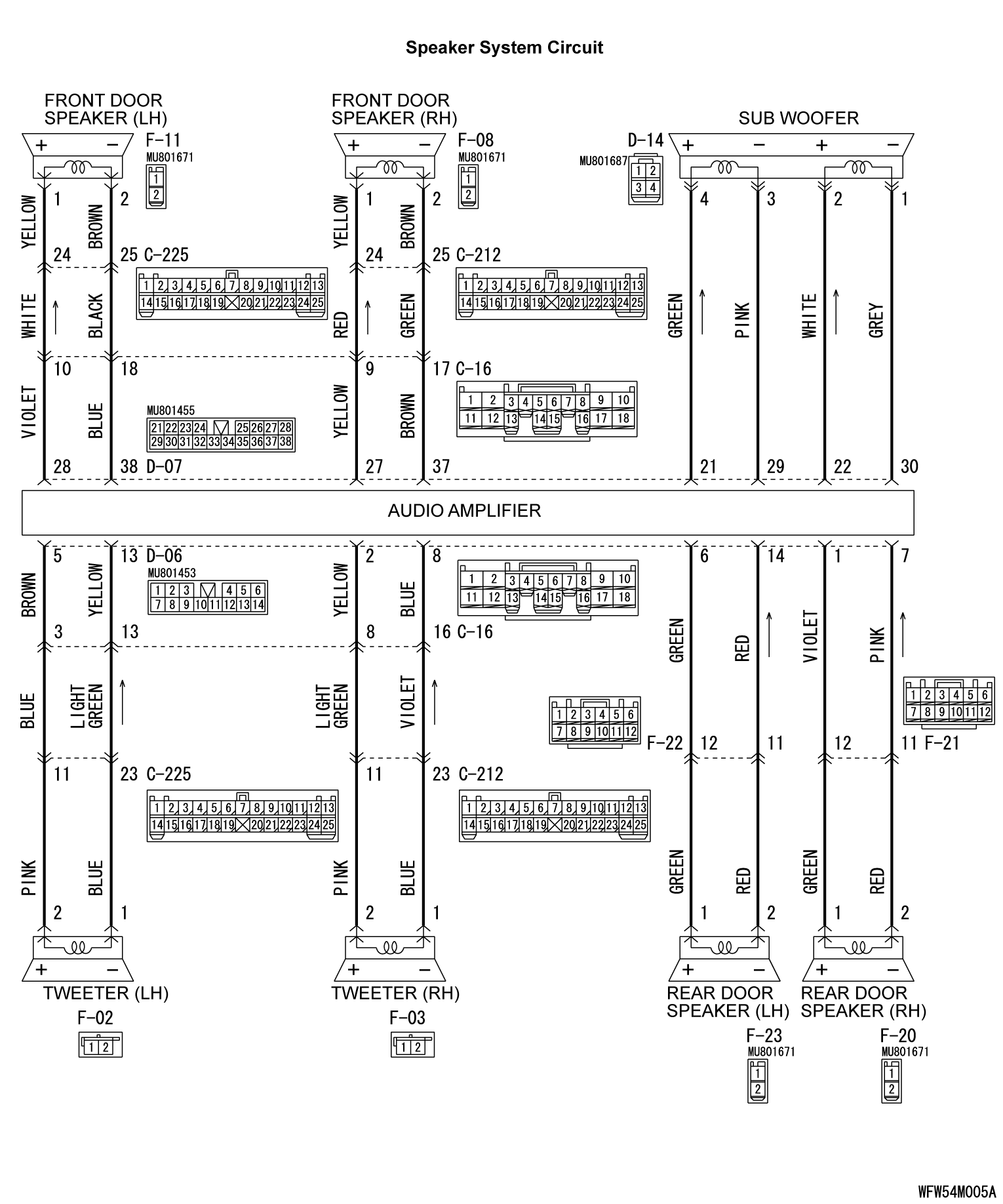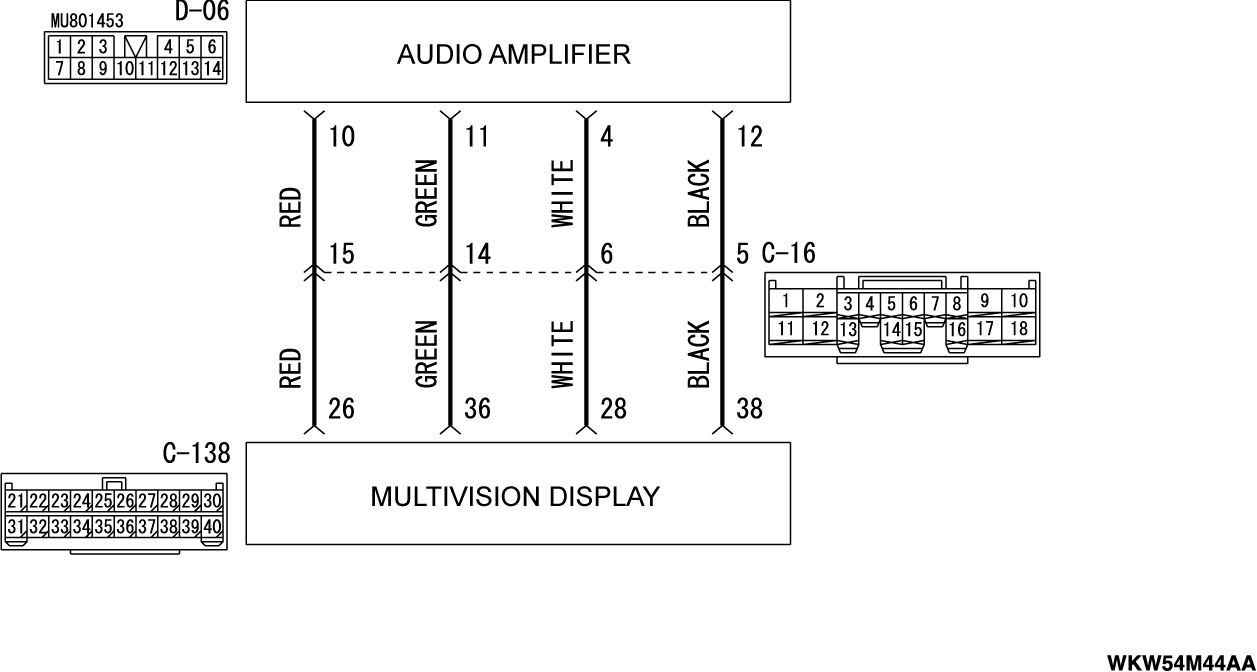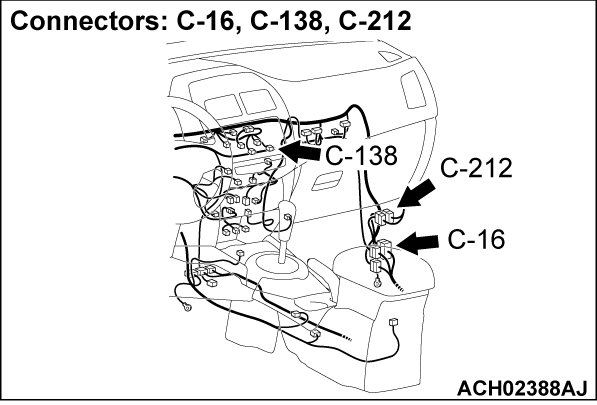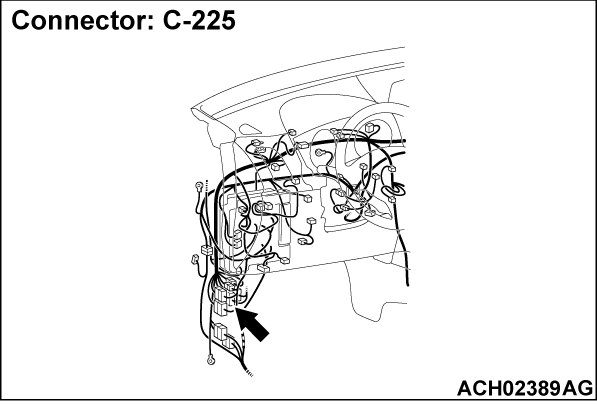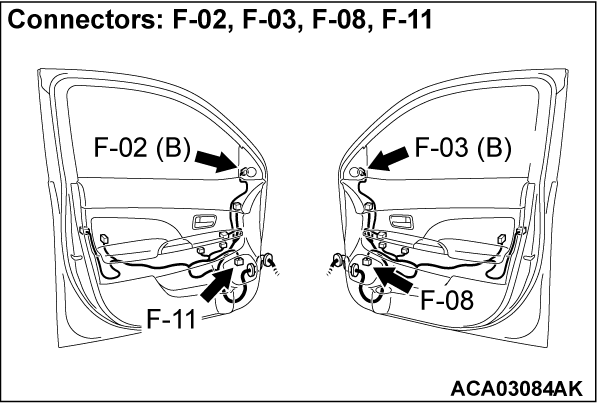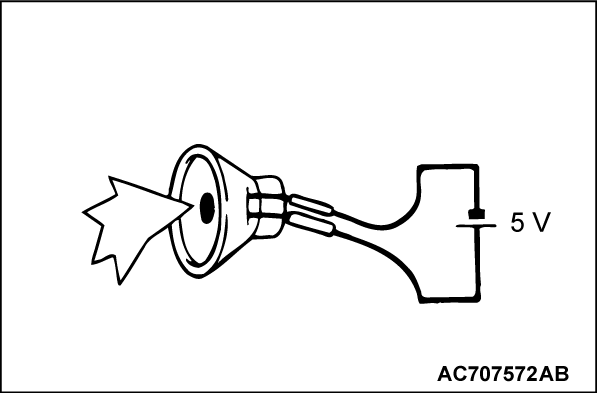Inspection Procedure 2: No sound is heard. <Vehicles with audio amplifier>
| caution | Before replacing the multivision display, ensure that the power supply circuit, the ground circuit and the communication circuit are normal. |
TECHNICAL DESCRIPTION (COMMENT)
If the audio sound is not output, the multivision display may have a problem. In addition, if any of the speakers, tweeters or subwoofer is short-circuited, the protection circuit inside the multivision display disables all the speakers, tweeters or subwoofer to sound. Therefore, if all the speakers do not output sound, the speaker, tweeter or subwoofer circuit may be shorted or the speaker, tweeter, subwoofer or audio amplifier may be defective.
TROUBLESHOOTING HINTS
- The multivision display may be defective
- The audio amplifier may be defective
- The speaker, tweeter or subwoofer may be defective
- The wiring harness or connectors may have loose, corroded, or damaged terminals, or terminals pushed back in the connector
DIAGNOSIS
Required Special Tools:
- MB991223: Harness Set
- MB992006: Extra Fine Probe
STEP 1. Checking with audio speaker test.
Perform the audio speaker test, and check which speaker, tweeter or subwoofer does not output the sound.
Is the check result normal?
STEP 2. Check the speaker, tweeter or subwoofer.
(1) Remove the speaker, tweeter or subwoofer.
(2) Check that the speaker, tweeter or subwoofer outputs the noise when the voltage of 5 V is applied to the speaker, tweeter or subwoofer connector terminal.
Is the check result normal?
 Replace the speaker, tweeter or subwoofer.
Replace the speaker, tweeter or subwoofer.STEP 3. Check the following connectors.
Check the following connectors:
- C-138 multivision display connector
- D-06, D-07 audio amplifier connector
- D-14 sub woofer connector
- F-11 front door speaker (LH) connector
- F-08 front door speaker (RH) connector
- F-23 rear door speaker (LH) connector
- F-20 rear door speaker (RH) connector
- F-02 tweeter (LH) connector
- F-03 tweeter (RH) connector
Are all the connectors in good condition?
STEP 4. Check the wire harness between the speaker, tweeter or subwoofer connector terminal and the audio amplifier connector terminal.
Check the communication lines for short circuit. The wiring harness may be damaged or the connector(s) may have loose, corroded or damaged terminals, or terminals pushed back in the connector. Repair the wiring harness as necessary.
The wiring harness may be damaged or the connector(s) may have loose, corroded or damaged terminals, or terminals pushed back in the connector. Repair the wiring harness as necessary.
- <Front door speaker (LH)> Check the wiring harness between front door speaker (LH) connector F-11 (terminal 1, 2) and audio amplifier connector D-07 (terminal 28, 38).
- <Front door speaker (RH)> Check the wiring harness between front door speaker (RH) connector F-08 (terminal 1, 2) and audio amplifier connector D-07 (terminal 26, 36).
- <Rear door speaker (LH)> Check the wiring harness between rear door speaker (LH) connector F-23 (terminal 1, 2) and audio amplifier connector D-06 (terminal 6, 14).
- <Rear door speaker (RH)> Check the wiring harness between rear door speaker (RH) connector F-20 (terminal 1, 2) and audio amplifier connector D-06 (terminal 1, 7).
- <Tweeter (LH)> Check the wiring harness between tweeter (LH) connector F-02 (terminal 1, 2) and audio amplifier connector D-06 (terminal 13, 5).
- <Tweeter (RH)> Check the wiring harness between tweeter (RH) connector F-03 (terminal 1, 2) and audio amplifier connector D-06 (terminal 8, 2).
- <Subwoofer> Check the wiring harness subwoofer connector D-14 (terminal 1, 2, 3, 4) and audio amplifier connector D-06 (terminal 30, 22, 29, 21).
Is the check result normal?
 The wiring harness may be damaged or the connector(s) may have loose, corroded or damaged terminals, or terminals pushed back in the connector. Repair the wiring harness as necessary.
The wiring harness may be damaged or the connector(s) may have loose, corroded or damaged terminals, or terminals pushed back in the connector. Repair the wiring harness as necessary.STEP 5. Check the speaker, tweeter or subwoofer.
Follow the speaker test to check which speaker, tweeter or subwoofer does not sound. Replace the speaker, tweeter or subwoofer.
Replace the speaker, tweeter or subwoofer.
(1) Remove the speaker, tweeter or subwoofer.
(2) Check that the speaker, tweeter or subwoofer outputs the noise when the voltage of 5 V is applied to the speaker, tweeter or subwoofer connector terminal.
Do the speaker output the noise?
 Replace the speaker, tweeter or subwoofer.
Replace the speaker, tweeter or subwoofer.STEP 6. Check the following connectors.
Check the following connectors:
- C-138 multivision display connector
- D-06, D-07 audio amplifier connector
- D-14 sub woofer connector
- F-11 front door speaker (LH) connector
- F-08 front door speaker (RH) connector
- F-23 rear door speaker (LH) connector
- F-20 rear door speaker (RH) connector
- F-02 tweeter (LH) connector
- F-03 tweeter (RH) connector
Are all the connectors in good condition?
STEP 7. Check the wire harness between the speaker, tweeter or subwoofer connector terminal and audio amplifier connector terminal.
Follow the speaker test to check which speaker, tweeter or subwoofer circuit is defective. The wiring harness may be damaged or the connector(s) may have loose, corroded or damaged terminals, or terminals pushed back in the connector. Repair the wiring harness as necessary.
The wiring harness may be damaged or the connector(s) may have loose, corroded or damaged terminals, or terminals pushed back in the connector. Repair the wiring harness as necessary.
Check the communication lines for short circuit.
- <Front door speaker (LH)> Check the wiring harness between front door speaker (LH) connector F-11 (terminal 1, 2) and audio amplifier connector D-07 (terminal 28, 38).
- <Front door speaker (RH)> Check the wiring harness between front door speaker (RH) connector F-08 (terminal 1, 2) and audio amplifier connector D-07 (terminal 26, 36).
- <Rear door speaker (LH)> Check the wiring harness between rear door speaker (LH) connector F-23 (terminal 1, 2) and audio amplifier connector D-06 (terminal 6, 14).
- <Rear door speaker (RH)> Check the wiring harness between rear door speaker (RH) connector F-20 (terminal 1, 2) and audio amplifier connector D-06 (terminal 1, 7).
- <Tweeter (LH)> Check the wiring harness between tweeter (LH) connector F-02 (terminal 1, 2) and audio amplifier connector D-06 (terminal 13, 5).
- <Tweeter (RH)> Check the wiring harness between tweeter (RH) connector F-03 (terminal 1, 2) and audio amplifier connector D-06 (terminal 8, 2).
- <Subwoofer> Check the wiring harness subwoofer connector D-14 (terminal 1, 2, 3, 4) and audio amplifier connector D-06 (terminal 30, 22, 29, 21).
Is the check result normal?
 The wiring harness may be damaged or the connector(s) may have loose, corroded or damaged terminals, or terminals pushed back in the connector. Repair the wiring harness as necessary.
The wiring harness may be damaged or the connector(s) may have loose, corroded or damaged terminals, or terminals pushed back in the connector. Repair the wiring harness as necessary.STEP 8. Check the harness wire between multivision display connector C-138 (terminal 26, 28, 36, 38) and audio amplifier connector D-06 (terminal 10, 4, 11, 12).
- Check the communication lines for open circuit and short circuit.
Is the wiring harness between multivision display connector C-138 (terminal 26, 28, 36, 38) and audio amplifier connector D-06 (terminal 10, 4, 11, 12) in good condition?
 The wiring harness may be damaged or the connector(s) may have loose, corroded or damaged terminals, or terminals pushed back in the connector. Repair the wiring harness as necessary.
The wiring harness may be damaged or the connector(s) may have loose, corroded or damaged terminals, or terminals pushed back in the connector. Repair the wiring harness as necessary.![[Previous]](../../../buttons/fprev.png)
![[Next]](../../../buttons/fnext.png)
